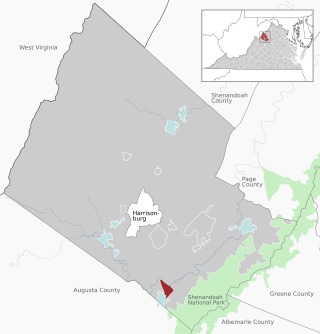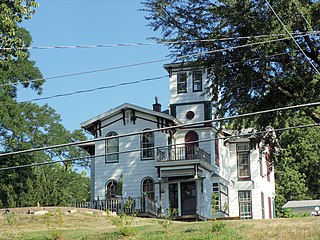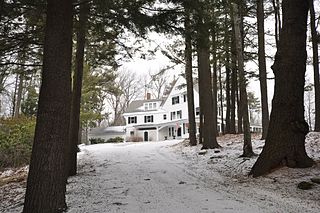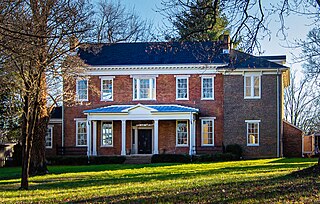
The Stonington Harbor Light is a historic lighthouse built in 1840 and located on the east side of Stonington Harbor in the Borough of Stonington, Connecticut. It is a well-preserved example of a mid-19th century stone lighthouse. The light was taken out of service in 1889 and now serves as a local history museum. It was listed on the National Register of Historic Places in 1976.

The Ruskin Colony was a utopian socialist colony which existed near Tennessee City in Dickson County, Tennessee from 1894 to 1896. The colony moved to a slightly more permanent second settlement on an old farm five miles north from 1896 to 1899, and saw another brief incarnation near Waycross, in southern Georgia, from 1899 until it finally dissolved in 1901. Its regional location within the Southern United States set it apart from many other similar utopian projects of the era. At its high point, the population was around 250. The colony was named after John Ruskin, the English socialist writer. A cave on the colony's second property in Dickson County still carries his name. The site of the colony's second settlement in Dickson County is listed on the National Register of Historic Places.

The Appeal to Reason was a weekly left-wing political newspaper published in the American Midwest from 1895 until 1922. The paper was known for its politics, lending support over the years to the Farmers' Alliance and People's Party before becoming a mainstay of the Socialist Party of America, following that organization's establishment in 1901. Making use of a network of highly motivated volunteers known as the "Appeal Army" to spur subscription sales, paid circulation of the Appeal climbed to more than a quarter-million copies by 1906 and half a million by 1910, making it the largest-circulation socialist newspaper in American history.

Julius Augustus Wayland was a Midwestern US socialist during the Progressive Era. He is most noted for publishing Appeal to Reason, a socialist publication often deemed to be the most important socialist periodical of the time.

Port Republic is a census-designated place in Rockingham County, Virginia, United States. The Battle of Port Republic occurred there in the American Civil War.
J. Foster Warner (1859–1937), also known as John Foster Warner, was a Rochester, New York-based architect. He was the son of one of Rochester's most prominent 19th century architects, Andrew Jackson Warner (1833-1910). After receiving his architectural training in his father's office, the younger Warner opened his own office in 1889 and remained in continuous practice until his death in 1937.

The Gustaf Adolph Lutheran Church is a historic church at 29 Capitol Hill Road in New Sweden, Maine. The congregation was established by Swedish immigrants to the area in 1871, and the Gothic Revival sanctuary was built in 1879-80. In 1896 the church was named in honor of King Gustavus Adolphus of Sweden. It was listed on the National Register of Historic Places in 1997. The church congregation was in 2003 subjected to one of the nation's largest cases of arsenic poisoning, perpetrated by one of its parishioners.

St. Bernard's Church and Parish House is a historic church complex located at 88 Claremont Road in the borough of Bernardsville in Somerset County, New Jersey. This Episcopal Church in the Episcopal Diocese of New Jersey is named after St. Bernard of Clairvaux. It was added to the National Register of Historic Places on September 6, 2006, for its significance in architecture.

The Thomas C. Wilkinson House is a historic building located in the West End of Davenport, Iowa, United States. The residence has been listed on the National Register of Historic Places since 1984.

The Nashua Manufacturing Company Historic District in Nashua, New Hampshire, is a historic district that was listed on the National Register of Historic Places (NRHP) in 1987. It encompasses an area just west of downtown Nashua, roughly located along the southern bank of the Nashua River, bordered on the west side by Mine Falls Park, on the south side by the Nashua River canal, up to Ledge Street, and from the east side by Factory, Pine and Water streets, up to the Main Street bridge.

The Louis Cabot House is a historic house on Windmill Hill Road in Dublin, New Hampshire. Built in 1887, it is a distinctive local example of Shingle style architecture, and was the centerpiece of the large country estate of industrialist Louis Cabot. The house was listed on the National Register of Historic Places in 1983.

Rally Hill is a historic mansion in Columbia, Tennessee, U.S.. It has been listed on the National Register of Historic Places since August 16, 1984.

Villa Mira Monte is a historic villa in Morgan Hill, California, United States, which is listed on the National Register of Historic Places. It was built for Hiram Morgan Hill, founder of Morgan Hill, and his wife Diana Murphy Hill, a Californio heiress.

The Warm Springs Avenue Historic District in Boise, Idaho, is a residential area with 96 contributing houses representing a variety of architectural styles constructed between 1870 and 1940. The district includes Queen Anne, Colonial Revival, Tudor Revival, Bungalow, and other styles representing the work of architects Tourtellotte & Hummel, Wayland & Fennell, Kirtland Cutter, and others. The Children's Home Society of Idaho occupies the largest structure in the district, and its buildings are the only structures that are not houses.

The Clark House is a historic house in Clarksville, Idaho. It was built in 1912 as a summer residence for F. Lewis Clark, a mining millionaire who disappeared in Santa Barbara in 1914 and was believed to have committed suicide. Clark's servants lived in the wings. The house was designed in the American colonial style and has been attributed to architect Kirtland Cutter; however, blueprints discovered in Boise, ID show that the actual architect was George Canning Wales of Boston. It has been listed on the National Register of Historic Places since December 12, 1978.

Lafayette School is a fieldstone schoolhouse built in 1921 and located at 79 Mill Road in the Lower Berkshire Valley section of Roxbury Township in Morris County, New Jersey. It was added to the National Register of Historic Places on September 1, 2022, for its significance in architecture. Designed by the architectural firm of Rasmussen & Wayland from New York City, the school features American Craftsman style.
















